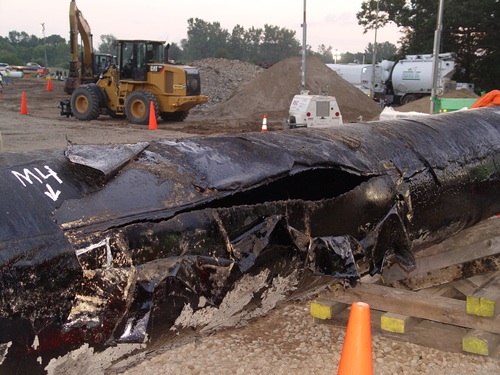It was the most expensive pipeline oil spill in the country’s history, the fallout from which still plagues the local communities, and government investigators have found that it was entirely preventable.
The National Transportation Safety Board released its findings from a two year investigation of the 2010 Enbridge tar sands crude pipeline spill (which DeSmogBlog has covered in depth) that dumped over a million gallons of toxic diluted bitumen (or DilBit) into the Kalamazoo River and its watershed.
“Complete breakdown of safety.”
The report draws two very stark, clear conclusions about Enbridge’s culture of safety, or lack thereof.
First, Enbridge had known of corrosion and cracking along the 6B pipeline for five years, but the company refused to make repairs.
“Enbridge detected the very defect that led to this failure (in 2005),” said NTSB Chairman Deborah A.P. Hersman, “…Yet for five years they did nothing to address the corrosion or cracking at the site, and the problem festered.” (You can watch video of the NTSB announcements here.)
Second, after the rupture, Enbridge employees had many opportunities to minimize the volume and impact of the spill, but failed repeatedly.
“This investigation identified a complete breakdown of safety at Enbridge. Their employees performed like Keystone Kops and failed to recognize their pipeline had ruptured and continued to pump crude into the environment.” Hersman continued, “Despite multiple alarms and a loss of pressure in the pipeline, for more than 17 hours and through three shifts they failed to follow their own shutdown procedures.”
For a great blow-by-blow account of this “complete breakdown of safety” in the Enbridge operations center, don’t miss the incredible in-depth report by Elizabeth McGowan and Lisa Song of InsideClimate News.
This report from the NTSB comes a week after the Pipeline and Hazardous Materials Safety Administration of the Department of Transportation announced that Enbridge would be fined $3.7 million for 24 safety violations associated with the spill.
The $3.7 million claim was a record for the agency, but it’s a slap on the wrist considering the overall costs of the spill. The EPA and Enbridge estimate clean-up costs alone at over $800 million (and counting), and that’s to say nothing of the economic losses suffered by the affected region.
As Kari Lydersen reported for OnEarth a year after the spill, the town of Marshall, Michigan still “resembled a town under seige,” as the oil spill response and recovery efforts have proven far more difficult – and costly – than anyone imagined. (This has a lot to do with the fact that the ruptured pipeline 6B was carrying DilBit, and not traditional crude. As we’ve written before and as Lydersen explained, DilBit is actually far more difficult to clean up than conventional oil.)
“Fox guarding the hen house.”
Though the NTSB report assigns the majority of the blame squarely on Enbridge’s indifference and ineptitude, the board also called out lax oversight and regulation by federal agencies. “”We saw the operator take advantage of weak regulations,” said Chairman Hersman in her public comments.
In the “Probable Cause” section of the NTSB synopsis, the Board notes:
Contributing to the accident was the Pipeline and Hazardous Materials Safety Administration’s (PHMSA) weak regulation for assessing and repairing crack indications, as well as PHMSA‘s ineffective oversight of pipeline integrity management programs, control center procedures, and public awareness.
NTSB Chairman Hersman was more direct in her remarks:
This accident is a wake-up call to the industry, the regulator, and the public. Enbridge knew for years that this section of the pipeline was vulnerable yet they didn’t act on that information. Likewise, for the regulator to delegate too much authority to the regulated to assess their own system risks and correct them is tantamount to the fox guarding the hen house. Regulators need regulations and practices with teeth, and the resources to enable them to take corrective action before a spill. Not just after.
Keep in mind, this is the Board chair of a federal agency calling out the lax practices of partner agencies. The strength of her words are telling.
Quiet on tar sands crude
While the NTSB report was damning to Enbridge and regulators alike, it was curiously quiet on the issue of tar sands crude itself. As we’ve written before, this DilBit blend of crude is not only more difficult to clean up than conventional crude, but due to its highly corrosive and volatile nature, is also more likely to actually cause pipeline ruptures and spills.
Last year, a joint report by the Natural Resources Defense Council (NRDC), the Pipeline Safety Trust, the National Wildlife Federation and the Sierra Club spotlighted the specific threats of tar sands crude to pipelines. It warned that pumping DilBit at high volumes, common practice in the industry, could cause corrosion and cracking – exactly what was found to have caused the spill from Enbridge’s pipeline 6B.
The report and remarks by the NTSB continuously referred to the Enbridge spill as “crude oil,” but never specified that it was in fact DilBit.
If the NTSB and other regulatory agencies don’t recognize the amplified threat that DilBit crude poses to pipelines, and doesn’t create or enforce stricter safety measures for these vulnerable pipelines, then they can expect to have a lot more spills to investigate.
Subscribe to our newsletter
Stay up to date with DeSmog news and alerts








